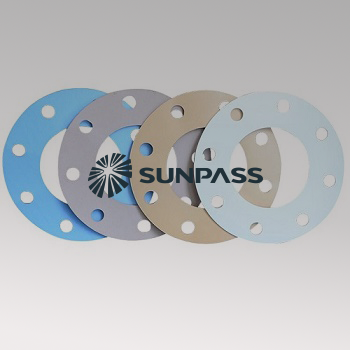PTFE gaskets are made of pure PTFE powder or mixed materials, PTFE plates, rods, tubes, etc., and are processed by molding, turning or cutting. Among the known plastics, PTFE has the best chemical resistance, no aging, low friction coefficient, and wear resistance. Modified PTFE gaskets are made by evenly adding glass fiber, carbon fiber, graphite powder and other filling materials to traditional pure PTFE gaskets.
Modified PTFE gaskets are also called filled PTFE gaskets. They are made by adding a certain amount of fillers to PTFE resin, such as glass fiber, bronze powder, molybdenum disulfide, graphite, carbon fiber, etc., and then pressing them into shape with a mold after high-speed mixing. Then, they are sintered at high temperature to make gaskets and other products, or first pressed into modified PTFE plates and then stamped or cut into shape. Filled PTFE gaskets greatly improve certain properties of PTFE by adding a certain amount of fillers to PTFE products, especially in terms of wear resistance, thermal conductivity, anti-waxing, self-lubrication, etc., which are significantly improved compared with pure PTFE products. Suitable for corrosion-resistant, heat-conductive, wear-resistant, oil-free lubricated, shock-absorbing and wear-resistant seal lubricating and conducting parts in the temperature range of -180℃~+250℃.
Industries for modified PTFE gaskets: chemical, petrochemical, oil refining, chlor-alkali, acid, phosphate fertilizer, pharmaceutical, pesticide, chemical fiber, dyeing, coking, coal gas, organic synthesis, non-ferrous smelting, steel, atomic energy and high-purity product production (such as ion membrane electrolysis), viscous material transportation and operation, food and beverage processing and production departments with highly stringent hygiene requirements.
Equipment used: Sealing parts of flange connections of pipelines, valves, pumps, pressure vessels, heat exchangers, condensers, generators, air compressors, exhaust pipes, refrigerators, etc.
Performance characteristics of modified PTFE gaskets:
The performance of modified (filled) PTFE is closely related to the performance, content and preparation process of the filling material. Fillers must meet the following requirements: (1) Fillers are stable under 380-400℃ sintering conditions; (2) Filler particle size is ≤150µm; (3) Fillers do not absorb moisture; (4) Fillers do not aggregate under sintering conditions; (5) Fillers do not react with PTFE.
Common fillers: graphite, molybdenum disulfide, ceramic particles/fibers, carbon fibers (CF), glass beads and glass fibers (GF), quartz, barium sulfate, etc.
1. Improve cold flow resistance and creep resistance: fill with graphite, glass beads and glass fibers (GF, polyphenylene sulfide
2. Improve lubricity: fill with MoS2,
3. Improve thermal conductivity: fill with bronze powder, molybdenum, nickel, etc., carbon fibers
4. Improve wear resistance: fill with glass beads and glass fibers (GF), polyimide, polyphenylene ester
5. Improve stability and reduce deformation: carbon fibers, polyphenylene sulfide
